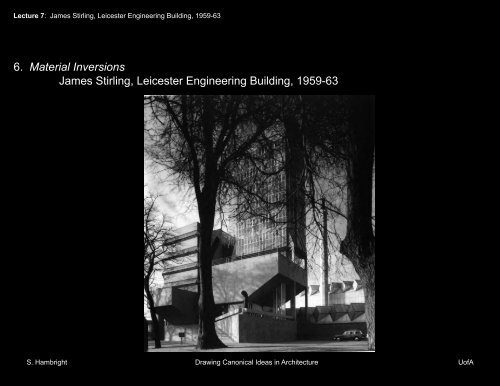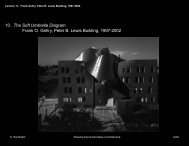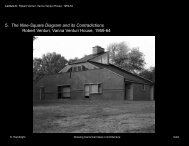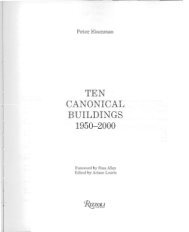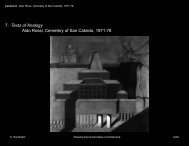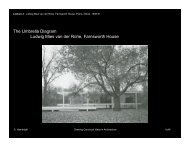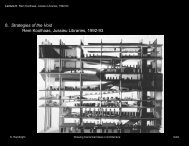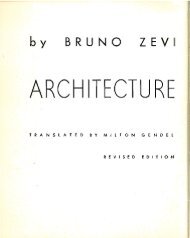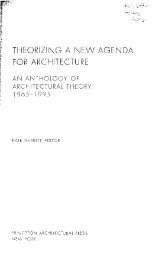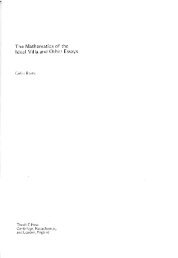6. Material Inversions James Stirling, Leicester Engineering Building ...
6. Material Inversions James Stirling, Leicester Engineering Building ...
6. Material Inversions James Stirling, Leicester Engineering Building ...
Create successful ePaper yourself
Turn your PDF publications into a flip-book with our unique Google optimized e-Paper software.
Lecture 7: <strong>James</strong> <strong>Stirling</strong>, <strong>Leicester</strong> <strong>Engineering</strong> <strong>Building</strong>, 1959-63<strong>6.</strong> <strong>Material</strong> <strong>Inversions</strong><strong>James</strong> <strong>Stirling</strong>, <strong>Leicester</strong> <strong>Engineering</strong> <strong>Building</strong>, 1959-63S. Hambright Drawing Canonical Ideas in Architecture UofA
Lecture 7: <strong>James</strong> <strong>Stirling</strong>, <strong>Leicester</strong> <strong>Engineering</strong> <strong>Building</strong>, 1959-63Le Corbusier, Villa Stein“…confrontation between modernist abstraction and an incipient postmodern ‘reality’embodied in a material presence.“Philip Johnson, AT&T <strong>Building</strong>“…the English context immediately after World War II is significant in understanding thecritique of modernist abstraction embodied both materially and conceptually in the <strong>Leicester</strong><strong>Engineering</strong> <strong>Building</strong>.“S. Hambright Drawing Canonical Ideas in Architecture UofA
Lecture 7: <strong>James</strong> <strong>Stirling</strong>, <strong>Leicester</strong> <strong>Engineering</strong> <strong>Building</strong>, 1959-63Hitler and Mussolini“…modern architecture…was essentially a continental phenomenon with varying politicalaims.”S. Hambright Drawing Canonical Ideas in Architecture UofA
Lecture 7: <strong>James</strong> <strong>Stirling</strong>, <strong>Leicester</strong> <strong>Engineering</strong> <strong>Building</strong>, 1959-63Adolf HitlerProposed Nazi projects“In Germany in the 1920s, modernism was a left-oriented and Marxist-inspired movement...“S. Hambright Drawing Canonical Ideas in Architecture UofA
Lecture 7: <strong>James</strong> <strong>Stirling</strong>, <strong>Leicester</strong> <strong>Engineering</strong> <strong>Building</strong>, 1959-63Benito MussoliniPalazzo della Civita Italiana“…while in Italy after 1933, under Mussolini, modern architecture – in many cases even in thelater 1920s – represented the aesthetics of the fascist regime, classical rhetoric, andmonumentality.“S. Hambright Drawing Canonical Ideas in Architecture UofA
Lecture 7: <strong>James</strong> <strong>Stirling</strong>, <strong>Leicester</strong> <strong>Engineering</strong> <strong>Building</strong>, 1959-632 Reasons architectural culture in Englandwas affected by the war:- Refugees from Polish architectural schools- The war disrupted the education of an entiregeneration of students.1893 Columbia Exhibition, Chicago, IL“In England, as in America, the context for architecture could essentially be called pragmatic. Butunlike in the United States, which remained under the sway of a prewar Beaux-Arts influence,architectural culture in England was profoundly affected by the war.”S. Hambright Drawing Canonical Ideas in Architecture UofA
Lecture 7: <strong>James</strong> <strong>Stirling</strong>, <strong>Leicester</strong> <strong>Engineering</strong> <strong>Building</strong>, 1959-63Colin Rowe<strong>James</strong> <strong>Stirling</strong>“…Second, the war clearly disrupted the education of an entire generation of students.”S. Hambright Drawing Canonical Ideas in Architecture UofA
Lecture 7: <strong>James</strong> <strong>Stirling</strong>, <strong>Leicester</strong> <strong>Engineering</strong> <strong>Building</strong>, 1959-63Le Corbusier, Villa Stein, 1927-30Vladimir Tatlin, Tatlin’s Tower, 1920“Rowe began his studies at Liverpool in 1939, which had been a conservative school ofarchitecture before the war, but had radically changed with the influx in 1938-39 of Polishrefugees, many of whom had been active in the Modern Movement and introduced the schoolto Corbusian modernism and a form of Russian constructivism.”S. Hambright Drawing Canonical Ideas in Architecture UofA
Lecture 7: <strong>James</strong> <strong>Stirling</strong>, <strong>Leicester</strong> <strong>Engineering</strong> <strong>Building</strong>, 1959-63Colin RoweMathematics of the Ideal Villa“By the time (<strong>Stirling</strong>) returned to Liverpool in 1949, Rowe was his teacher, and <strong>Stirling</strong>completed his final thesis project in 1949 under Rowe and the profound influence of LeCorbusier.”S. Hambright Drawing Canonical Ideas in Architecture UofA
Lecture 7: <strong>James</strong> <strong>Stirling</strong>, <strong>Leicester</strong> <strong>Engineering</strong> <strong>Building</strong>, 1959-63This is Tomorrow catalogue, 1956“The 1950’s signaled a change in the climate for modernity in England as architects, artists,and sculptors focused on alternatives to modernist abstraction. Collaborative efforts such asthat of the Independent Group proclaimed an interest in everyday materials an an ‘as found’aesthetic...”S. Hambright Drawing Canonical Ideas in Architecture UofA
Lecture 7: <strong>James</strong> <strong>Stirling</strong>, <strong>Leicester</strong> <strong>Engineering</strong> <strong>Building</strong>, 1959-63<strong>James</strong> <strong>Stirling</strong>, This is Tomorrow, 1956“The 1950’s signaled a change in the climate for modernity in England as architects, artists,and sculptors focused on alternatives to modernist abstraction. Collaborative efforts such asthat of the Independent Group proclaimed an interest in everyday materials an an ‘as found’aesthetic...”S. Hambright Drawing Canonical Ideas in Architecture UofA
Lecture 7: <strong>James</strong> <strong>Stirling</strong>, <strong>Leicester</strong> <strong>Engineering</strong> <strong>Building</strong>, 1959-63Eduardo Paolozzi, This is Tomorrow, 1956“The 1950’s signaled a change in the climate for modernity in England as architects, artists,and sculptors focused on alternatives to modernist abstraction. Collaborative efforts such asthat of the Independent Group proclaimed an interest in everyday materials an an ‘as found’aesthetic...”S. Hambright Drawing Canonical Ideas in Architecture UofA
Lecture 7: <strong>James</strong> <strong>Stirling</strong>, <strong>Leicester</strong> <strong>Engineering</strong> <strong>Building</strong>, 1959-63Richard Hamilton, Just What Is It that Makes Today’s Homes So Different, So Appealing?, 1956“The 1950’s signaled a change in the climate for modernity in England as architects, artists,and sculptors focused on alternatives to modernist abstraction. Collaborative efforts such asthat of the Independent Group proclaimed an interest in everyday materials an an ‘as found’aesthetic...”S. Hambright Drawing Canonical Ideas in Architecture UofA
Lecture 7: <strong>James</strong> <strong>Stirling</strong>, <strong>Leicester</strong> <strong>Engineering</strong> <strong>Building</strong>, 1959-63Nigel Henderson, This is Tomorrow, 1956“The 1950’s signaled a change in the climate for modernity in England as architects, artists,and sculptors focused on alternatives to modernist abstraction. Collaborative efforts such asthat of the Independent Group proclaimed an interest in everyday materials an an ‘as found’aesthetic...”S. Hambright Drawing Canonical Ideas in Architecture UofA
Lecture 7: <strong>James</strong> <strong>Stirling</strong>, <strong>Leicester</strong> <strong>Engineering</strong> <strong>Building</strong>, 1959-63Peter and Alison Smithson, This is Tomorrow, 1956“The 1950’s signaled a change in the climate for modernity in England as architects, artists,and sculptors focused on alternatives to modernist abstraction. Collaborative efforts such asthat of the Independent Group proclaimed an interest in everyday materials an an ‘as found’aesthetic...”S. Hambright Drawing Canonical Ideas in Architecture UofA
Lecture 7: <strong>James</strong> <strong>Stirling</strong>, <strong>Leicester</strong> <strong>Engineering</strong> <strong>Building</strong>, 1959-63Alison and Peter Smithson, Robin Hood Gardens, 1966-72Team Ten meeting inSpoleto, Italy“Some of the participants – including the Smithsons – were equally involved in a post – CIAMgroup, Team Ten, which was dedicated to reviving the principles of modern architecture afterthe war. As a member of the Independent Group, <strong>Stirling</strong> was critical to Team Ten’s latemodernist ideology.”S. Hambright Drawing Canonical Ideas in Architecture UofA
Lecture 7: <strong>James</strong> <strong>Stirling</strong>, <strong>Leicester</strong> <strong>Engineering</strong> <strong>Building</strong>, 1959-63Gordon Cullen’s ‘Townscape”, 1964“If ‘This is Tomorrow’ drew attention to the cozy comforts of the postwar British consumerculture…the exhibition also led to several widely divergent offshoots....”S. Hambright Drawing Canonical Ideas in Architecture UofA
Lecture 7: <strong>James</strong> <strong>Stirling</strong>, <strong>Leicester</strong> <strong>Engineering</strong> <strong>Building</strong>, 1959-63Eduardo PaolozziI Was a Rich Man’s Plaything, 1947Peter Blake“If ‘This is Tomorrow’ drew attention to the cozy comforts of the postwar British consumerculture…the exhibition also led to several widely divergent offshoots....”S. Hambright Drawing Canonical Ideas in Architecture UofA
Lecture 7: <strong>James</strong> <strong>Stirling</strong>, <strong>Leicester</strong> <strong>Engineering</strong> <strong>Building</strong>, 1959-63Cedric Price and Archigram“If ‘This is Tomorrow’ drew attention to the cozy comforts of the postwar British consumerculture…the exhibition also led to several widely divergent offshoots....”S. Hambright Drawing Canonical Ideas in Architecture UofA
Lecture 7: <strong>James</strong> <strong>Stirling</strong>, <strong>Leicester</strong> <strong>Engineering</strong> <strong>Building</strong>, 1959-63Martello Tower, Aldeburgh, Suffolk, 1810-12“The impact of ‘This is Tomorrow’ created an impetus not only toward pop, but also toward atough form of neorealism…it was named ‘New Brutalism” by the critic for the ArchitecturalReview, Reyner Banham…a reaction to the image of a comfortable British lifestyle…orientedinstead toward and idea figured in blunt materials and forms...”S. Hambright Drawing Canonical Ideas in Architecture UofA
Lecture 7: <strong>James</strong> <strong>Stirling</strong>, <strong>Leicester</strong> <strong>Engineering</strong> <strong>Building</strong>, 1959-63Perspecta 6, 1960Luigi Moretti“An important later influence can be gathered from his article ‘The Functional Tradition’ andExpression’ in Perspecta 6, 1960. Here <strong>Stirling</strong> discussed Luigi Moretti’s plaster casts, whichcreated what <strong>Stirling</strong> called ‘solidified space.’”S. Hambright Drawing Canonical Ideas in Architecture UofA
Lecture 7: <strong>James</strong> <strong>Stirling</strong>, <strong>Leicester</strong> <strong>Engineering</strong> <strong>Building</strong>, 1959-63<strong>James</strong> <strong>Stirling</strong> and <strong>James</strong> Gowan, Ham Commons, 1955-58 <strong>James</strong> <strong>Stirling</strong> and <strong>James</strong> Gowan, Preston Housing, 1962“This seemingly paradoxical inversion of the material qualities of solid and void became atheme that <strong>Stirling</strong> would develop more didactically in his early works…which prefigured hisconceptualization of an inversion of materials at <strong>Leicester</strong>.”S. Hambright Drawing Canonical Ideas in Architecture UofA
Lecture 7: <strong>James</strong> <strong>Stirling</strong>, <strong>Leicester</strong> <strong>Engineering</strong> <strong>Building</strong>, 1959-63Le Corbusier, Villa Stein, Garches, France, 1927-30Le Corbusier, Maison Jaoul, Paris, 1951“<strong>Stirling</strong> emphasized the materiality of the Maison Jaoul, which he contrasted to the‘neutralized’ surfaces of Garches. <strong>Stirling</strong> noted that ‘it is disturbing to find little reference to therational principles which are the basis of the modern movement...’”S. Hambright Drawing Canonical Ideas in Architecture UofA
Lecture 7: <strong>James</strong> <strong>Stirling</strong>, <strong>Leicester</strong> <strong>Engineering</strong> <strong>Building</strong>, 1959-63Le Corbusier, Maison Jaoul, Paris, 1951“…and he saw in the Maison Jaoul not just a romantic or picturesque notion of postwar modernarchitecture but also, in its use of varied materials and a barrel vault, a profound critique ofmodern architecture.”S. Hambright Drawing Canonical Ideas in Architecture UofA
Lecture 7: <strong>James</strong> <strong>Stirling</strong>, <strong>Leicester</strong> <strong>Engineering</strong> <strong>Building</strong>, 1959-63Saint Andrew’s DormitoryCambridge History Faculty Library<strong>Leicester</strong> <strong>Engineering</strong> <strong>Building</strong>Florey <strong>Building</strong> at Queens College“<strong>Leicester</strong> is one of the first manifold critiques of modernism and the first in a series of <strong>Stirling</strong>’smajor university buildings in England, which include the Cambridge History Faculty Library, theFlorey <strong>Building</strong> at Queens College, Oxford, and the Saint Andrew’s Dormitory project inScotland.”S. Hambright Drawing Canonical Ideas in Architecture UofA
Lecture 7: <strong>James</strong> <strong>Stirling</strong>, <strong>Leicester</strong> <strong>Engineering</strong> <strong>Building</strong>, 1959-63<strong>Building</strong> MassesGlass ElementsBrick<strong>Leicester</strong> <strong>Engineering</strong> <strong>Building</strong>“This critique is manifested in three different ways: first, in the use of glass; second, in the useof modular ceramic units (brick and tile); and third, in the compositional organization of thebuilding’s masses.”S. Hambright Drawing Canonical Ideas in Architecture UofA
Lecture 7: <strong>James</strong> <strong>Stirling</strong>, <strong>Leicester</strong> <strong>Engineering</strong> <strong>Building</strong>, 1959-63Colin Rowe and Robert Slutzky, Transparency: Literal and Phenomenal, 1963“In modern architecture, glass was conceived and used as a literal void as well as a phenomenaltransparent material, as discussed by Colin Rowe and Robert Slutzky in their seminal article‘Transparency: Literal and Phenomenal’...”S. Hambright Drawing Canonical Ideas in Architecture UofA
Lecture 7: <strong>James</strong> <strong>Stirling</strong>, <strong>Leicester</strong> <strong>Engineering</strong> <strong>Building</strong>, 1959-63Mies Van der Rohe, Farnsworth House<strong>Leicester</strong> <strong>Engineering</strong> <strong>Building</strong>“<strong>Leicester</strong> marks the movement of glass from void to solid, in other words, a reversal of theconception of glass’s materiality, from literal void to conceptual solid.”S. Hambright Drawing Canonical Ideas in Architecture UofA
Lecture 7: <strong>James</strong> <strong>Stirling</strong>, <strong>Leicester</strong> <strong>Engineering</strong> <strong>Building</strong>, 1959-63<strong>Leicester</strong> <strong>Engineering</strong> <strong>Building</strong>, early drawings“The often published early axonometric drawing by <strong>Stirling</strong> is important in understanding theconceptual development of the material inversions.”S. Hambright Drawing Canonical Ideas in Architecture UofA
Lecture 7: <strong>James</strong> <strong>Stirling</strong>, <strong>Leicester</strong> <strong>Engineering</strong> <strong>Building</strong>, 1959-63<strong>Leicester</strong> <strong>Engineering</strong> <strong>Building</strong>, workshops<strong>Leicester</strong> <strong>Engineering</strong> <strong>Building</strong>, office block“<strong>Leicester</strong> marks the movement of glass from void to solid, in other words, a reversal of theconception of glass’s materiality, from literal void to conceptual solid…the addition of volumetricdiamond-shaped elements, which form both levels of the laboratory roof, and the horizontalglass projections replacing the banded glass striations of the office block.”S. Hambright Drawing Canonical Ideas in Architecture UofA
Lecture 7: <strong>James</strong> <strong>Stirling</strong>, <strong>Leicester</strong> <strong>Engineering</strong> <strong>Building</strong>, 1959-63<strong>Leicester</strong> <strong>Engineering</strong> <strong>Building</strong>, tower“In the drawing, (the curtain wall) element is flush with the brick fascia above it…while in theexecuted tower, the entire glass curtain wall is set forward of the brick fascia.”S. Hambright Drawing Canonical Ideas in Architecture UofA
Lecture 7: <strong>James</strong> <strong>Stirling</strong>, <strong>Leicester</strong> <strong>Engineering</strong> <strong>Building</strong>, 1959-63<strong>Leicester</strong> <strong>Engineering</strong> <strong>Building</strong>, chamfered corners“A third and minor change occurs in the glass under the parallel…lecture theater, where theglass element underneath the theater now has chamfered corners.”S. Hambright Drawing Canonical Ideas in Architecture UofA
Lecture 7: <strong>James</strong> <strong>Stirling</strong>, <strong>Leicester</strong> <strong>Engineering</strong> <strong>Building</strong>, 1959-63Walter Gropius, Bauhaus<strong>Leicester</strong> <strong>Engineering</strong> <strong>Building</strong>“All of those taken together have the same effect: what was seen in modernist abstraction astransparent, planar, and void is now to be read as more opaque, volumetric, and solid.”S. Hambright Drawing Canonical Ideas in Architecture UofA
Lecture 7: <strong>James</strong> <strong>Stirling</strong>, <strong>Leicester</strong> <strong>Engineering</strong> <strong>Building</strong>, 1959-63<strong>Leicester</strong> <strong>Engineering</strong> <strong>Building</strong>“It is also necessary to look at some of the other aspects of the building…There is a playbetween the glass elements, which are not structural but appear volumetric and structural, andthe brick units, which are laid vertically and made to resemble a surface veneer.”S. Hambright Drawing Canonical Ideas in Architecture UofA
Lecture 7: <strong>James</strong> <strong>Stirling</strong>, <strong>Leicester</strong> <strong>Engineering</strong> <strong>Building</strong>, 1959-63<strong>Leicester</strong> <strong>Engineering</strong> <strong>Building</strong>“This didactic use of materials clearly demonstrates the difference between glass as a plane,glass as part of a continuous surface, and glass as a volume that is clearly interrupted by andarticulated around this concrete haunch.”S. Hambright Drawing Canonical Ideas in Architecture UofA
Lecture 7: <strong>James</strong> <strong>Stirling</strong>, <strong>Leicester</strong> <strong>Engineering</strong> <strong>Building</strong>, 1959-63Why would Eisenman say<strong>Stirling</strong>’s strategies aretextual rather than formal?What do you think?<strong>Leicester</strong> <strong>Engineering</strong> <strong>Building</strong>“Chamfering and twisting are certain of <strong>Stirling</strong>’s strategies that suggest the glass again hasbecome conceptually more solid than the concrete structure of the building.”S. Hambright Drawing Canonical Ideas in Architecture UofA
Lecture 7: <strong>James</strong> <strong>Stirling</strong>, <strong>Leicester</strong> <strong>Engineering</strong> <strong>Building</strong>, 1959-63<strong>Leicester</strong> <strong>Engineering</strong> <strong>Building</strong>, glass stairwell and spiral stair“The transparent glass stair tower becomes a void that seems to hold up the large cantileveredmass of the auditorium, while the metal-panelled stair tower-the solid-is cut away, revealing thecorkscrew of a concrete staircase.”S. Hambright Drawing Canonical Ideas in Architecture UofA
Lecture 7: <strong>James</strong> <strong>Stirling</strong>, <strong>Leicester</strong> <strong>Engineering</strong> <strong>Building</strong>, 1959-63<strong>Leicester</strong> <strong>Engineering</strong> <strong>Building</strong>“Such a play of materiality – making the glass staircase appear to support a massive volumewhile the concrete staircase is dematerialized into a spiraling vector – confounds the propertiesconventionally associated with each material. ”S. Hambright Drawing Canonical Ideas in Architecture UofA
Lecture 7: <strong>James</strong> <strong>Stirling</strong>, <strong>Leicester</strong> <strong>Engineering</strong> <strong>Building</strong>, 1959-63Walter Gropius, The Bauhaus<strong>Leicester</strong> <strong>Engineering</strong> <strong>Building</strong>, centripetal force“…a modernist idea of a centrifugal composition, that is, one that moves its energy away fromthe center to the periphery. At <strong>Leicester</strong>, the organization of the volumes is centripetal…collapsing or being sucked down into the center of the volumetric massing. The diagonals of theramps and beveled lecture hall volumes slant toward this center as they pivot about the centralstair tower.”S. Hambright Drawing Canonical Ideas in Architecture UofA
Lecture 7: <strong>James</strong> <strong>Stirling</strong>, <strong>Leicester</strong> <strong>Engineering</strong> <strong>Building</strong>, 1959-63Melnikov, Russakov Worker’s Club, 1927“…a dynamic rotation that reveals the influence of Melnikov’s Russakov Worker’s Club…whileMelnikov’s project proposes a collapse toward the center, there is a lack of rotation in thecomposition of the projecting volume of the Russakov Club, while rotation is a primarycharacteristic of <strong>Leicester</strong>’s juxtaposed volumes. Melnikov’s volumes seem to float free, while<strong>Stirling</strong>’s volumes are pinned by the towers, which introduce a dynamic thrust downward.”S. Hambright Drawing Canonical Ideas in Architecture UofA
Lecture 7: <strong>James</strong> <strong>Stirling</strong>, <strong>Leicester</strong> <strong>Engineering</strong> <strong>Building</strong>, 1959-63<strong>Leicester</strong> <strong>Engineering</strong> <strong>Building</strong><strong>Leicester</strong> <strong>Engineering</strong> <strong>Building</strong>, structural elements“…a volumetric glass unit…It seems to slide or hover in an unstable position over the structure.”S. Hambright Drawing Canonical Ideas in Architecture UofA
Lecture 7: <strong>James</strong> <strong>Stirling</strong>, <strong>Leicester</strong> <strong>Engineering</strong> <strong>Building</strong>, 1959-63<strong>Leicester</strong> <strong>Engineering</strong> <strong>Building</strong>“…brick-tiled units are structural at the base, yet are surmounted by a concrete, lintel-likeelement above a reveal, which suggests that the concrete element is floating over the brick.”S. Hambright Drawing Canonical Ideas in Architecture UofA
Lecture 7: <strong>James</strong> <strong>Stirling</strong>, <strong>Leicester</strong> <strong>Engineering</strong> <strong>Building</strong>, 1959-63<strong>Leicester</strong> <strong>Engineering</strong> <strong>Building</strong>“In this sense, the ‘reality’ of the void is articulated as a slot or cut-away – in other words, as realspace – while the representation of void in glass – in other words, the ‘unreal’ voids – are treatedvolumetrically.”S. Hambright Drawing Canonical Ideas in Architecture UofA
Lecture 7: <strong>James</strong> <strong>Stirling</strong>, <strong>Leicester</strong> <strong>Engineering</strong> <strong>Building</strong>, 1959-63<strong>Leicester</strong> <strong>Engineering</strong> <strong>Building</strong>“This constant displacement in meaning and function of materials provokes the need to readmaterials as conceptual rather than phenomenal physical integers, producing a building that isneither picturesque nor expressionist but rather defines a textual use of materials.”S. Hambright Drawing Canonical Ideas in Architecture UofA


